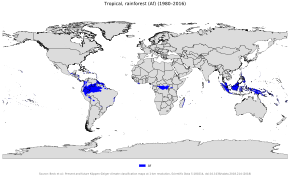
Back Tropiese reënwoud Afrikaans Tropischer Regenwald ALS Selva tropical AN غابة استوائية مطيرة Arabic Selva tropical AST Alas ujan tropis BAN Вільготныя трапічныя лясы Byelorussian Екваториални гори Bulgarian ক্রান্তীয় অতিবৃষ্টি অরণ্য Bengali/Bangla Koadeg trovanel gleb Breton



Tropical rainforests are dense and warm rainforests with high rainfall typically found between 10° north and south of the Equator. They are a subset of the tropical forest biome that occurs roughly within the 28° latitudes (in the torrid zone between the Tropic of Cancer and Tropic of Capricorn). Tropical rainforests are a type of tropical moist broadleaf forest, that includes the more extensive seasonal tropical forests.[3] True rainforests usually occur in tropical rainforest climates where no dry season occurs; all months have an average precipitation of at least 60 mm (2.4 in). Seasonal tropical forests with tropical monsoon or savanna climates are sometimes included in the broader definition.
Tropical rainforests ecosystems are distinguished by their consistent, high temperatures, exceeding 18 °C (64 °F) monthly, and substantial annual rainfall. The abundant rainfall results in nutrient-poor, leached soils, which profoundly affect the flora and fauna adapted to these conditions. These rainforests are renowned for their significant biodiversity. They are home to 40–75% of all species globally, including half of the world's animal and plant species, and two-thirds of all flowering plant species. Their dense insect population and variety of trees and higher plants are notable. Described as the "world's largest pharmacy", over a quarter of natural medicines have been discovered in them. However, tropical rainforests are threatened by human activities, such as logging and agricultural expansion, leading to habitat fragmentation and loss.
The structure of a tropical rainforest is stratified into layers, each hosting unique ecosystems. These include the emergent layer with towering trees, the densely populated canopy layer, the understory layer rich in wildlife, and the forest floor, which is sparse due to low light penetration. The soil is characteristically nutrient-poor and acidic. Tropical rainforests have a long history of ecological succession, influenced by natural events and human activities. They are crucial for global ecological functions, including carbon sequestration and climate regulation. Many indigenous peoples around the world have inhabited rainforests for millennia, relying on them for sustenance and shelter, but face challenges from modern economic activities.
Conservation efforts are diverse, focusing on both preservation and sustainable management. International policies, such as the Reducing Emissions from Deforestation and Forest Degradation (REDD and REDD+) programs, aim to curb deforestation and forest degradation. Despite these efforts, tropical rainforests continue to face significant threats from deforestation and climate change, highlighting the ongoing challenge of balancing conservation with human development needs.
- ^ Why the Amazon Rainforest is So Rich in Species Archived 25 February 2011 at the Wayback Machine. Earthobservatory.nasa.gov (5 December 2005). Retrieved on 28 March 2013.
- ^ Why The Amazon Rainforest Is So Rich In Species. ScienceDaily.com (5 December 2005). Retrieved on 28 March 2013.
- ^ Cite error: The named reference
Olsonwas invoked but never defined (see the help page).